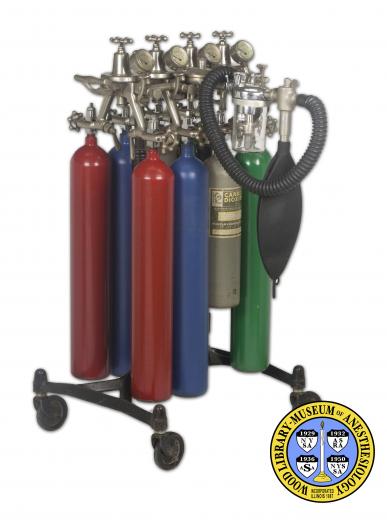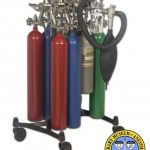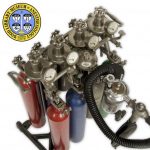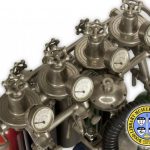Lundy Rochester Model Machine
Introduced in 1924, the Lundy Rochester Anesthesia Machine allowed for ethylene, nitrous oxide, carbon dioxide, oxygen and ether to be administered to the patient via separate controls on a single apparatus. Dr. John S. Lundy (1894-1973) worked with dentist, inventor, and manufacturer Jay A. Heidbrink (1875-1957) to develop this machine. It is more elaborate than the first four-gas machine, Foregger’s Seattle Model, which was designed a year earlier upon Lundy’s recommendations.
Lundy was an extremely productive anesthesiologist with numerous accomplishments to his name. Collaborating with others, Dr. Lundy developed and improved a variety of anesthetic devices, including needles and syringes for regional anesthesia and an early ventilator. He established the first anatomy lab at the Mayo Clinic and the first blood bank in the United States. Lundy developed the concept of 'balanced anesthesia,' and played a large role in the development of intravenous anesthesia.
Catalog Record: Lundy Rochester Model Machine
Access Key: aiqf
Accession No.: 2010-09-23-6
Title: Lundy Rochester model / [designed by John S. Lundy and Jay A. Heidbrink].
Author: Lundy, John Silas, 1894-1973.
Author: Heidbrink, Jay A., 1875-1957.
Corporate Author: Heidbrink Co.
Title variation: Alt Title
Title: Lundy-Rochester model Heidbrink apparatus.
Title variation: Alt Title
Title: Lundy Rochester model: surgical unit no. 50.
Title variation: Alt Title
Title: Lundy-Rochest model anesthetizer.
Publisher: Minneapolis, Minn.: Heidbrink Co., [1927-1940].
Physical Description: 1 anesthesia delivery apparatus : metals (including nickel plating), glass ; 29 x 57 x 38 cm.
Subject: Anesthesia, Inhalation.
Subject: Anesthesia Machines.
Subject: Nitrous Oxide.
Subject: Ethylenes.
Subject: Ether, Ethyl.
Subject: Carbon Dioxide.
Subject: Lundy, John S.
Note Type: General
Notes: Title from manufacturer markings on the apparatus; Alternate titles from the
manufacturer’s publications.
Note Type: With
Notes: The apparatus is on a cast-iron stand with two poles and four wheels; The
stand is painted black and has the Heidbrink logo and markings.
Note Type: Citation
Notes: Ellis TA, Narr BJ, Bacon DR. Developing a specialty: J.S. Lundy’s three major
contributions to anesthesiology. J Clin Anesth. 2004;16(3):226-229.
Note Type: Physical Description
Notes: An apparatus to administer anesthesia consisting of four control-units, a
volume-control valve/mixing chamber (also called the automat), two manifolds,
and two stirrup-handles; Each control-unit consists of a pressure-gauge, a
pressure-reducing valve with a handwheel at the top, and two gas tank
stabilizing yokes; All but the control-unit for carbon dioxide have a
direct-flow push-lever; Each yoke has a handwheel to tighten the tank into
place, and a shut-off-valve turn-lever; A bubble-through type ether-vaporizer
can be attached to the output of the automat; A metal connection for the
rebreathing bag, tubing and mask may be attached to the output of the ether
vaporizer if used; Behind the automat is a metal plate with manufacturer’s
markings: “LUNDY [new line] ROCHESTER MODEL [new line] HEIDBRINK [new line
with the Heidbrink logo, and then another new line] THE HEIDBRINK CO. [new
line] PAT. APPLIED FOR [spaces] MADE IN U.S.A.”; The gas gauges run left to
right with the control-units; The left-most gauge is marked for ethylene; The
next gauge on the right is labeled for nitrous-oxide (spelled “oxid”; The
third gauge from the left is labeled for carbon-dioxide (spelled “oxid”); The
right-most gauge is labeled for oxygen; The manifold that connects each
pressure-reducing valve to the automat is located in front of valves and
behind the automat; The manifold that runs behind the pressure-reducing
valves bypasses the automat via a metal tube that bends to run below the
automat and up into the metal tube that exits the automat; An adjustable-knob
on top of the automat is marked with five short vertical lines that are
numbered with 3, 5, 10, 15, and 20; The numbered lines can be aligned with a
stationary vertical line below the adjustable knob by turning the knob left
or right.
Note Type: Reproduction
Notes: Photographed by Mr. William Lyle, Sept. 23, 2010; Photographed with tubing,
bag, and mask not original to the apparatus; Also, photographed with a
vaporizer taken from a different example of the Lundy Rochester model.
Note Type: Historical
Notes: Dr. John S. Lundy was an extremely productive anesthesiologist with numerous
major accomplishments to his name, including the founding of the first
anatomy lab at the Mayo Clinic, the development of intravenous anesthesia and
the concept of ‘balanced anesthesia’ and the establishment of first blood
bank in the US in 1935 (Ellis, Narr, Bacon, 2003). He collaborated with
others to develop and improve a variety of anesthetic devices, including
needles and syringes for regional anesthesia and an early ventilator (Ellis,
Narr, Bacon, 2003). In 1925, just a year after arriving at the Mayo Clinic,
Dr. Lundy began working with dentist, inventor, and manufacturer Jay A.
Heidbrink on the first Lundy Heidbrink model (Keys, 1945). The Lundy
Rochester model allowed for ethylene, nitrous oxide, carbon-dioxide, oxygen
and ether to be at the ready and delivered to the patient via separate
controls on a single apparatus. It is more elaborate than the first four-gas
machine, Foregger’s “Seattle Model,” which was designed a year earlier upon
Lundy’s recommendations.




